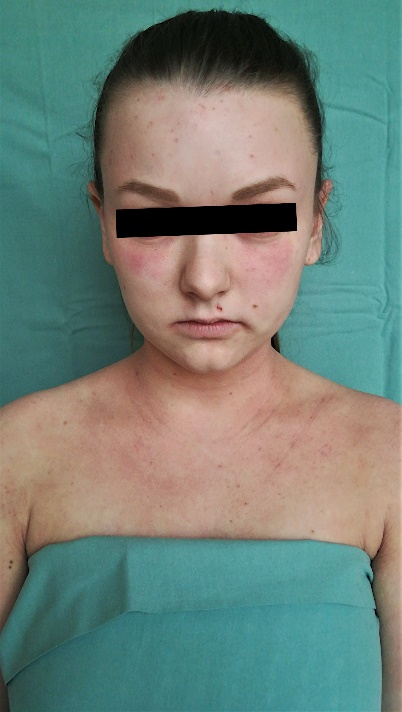Possibilities of Using a Topical Immunomodulator for Exacerbation of Atopic Eczema – Case Study
A 17-year-old high school student consulted a dermatologist due to the exacerbation of atopic eczema symptoms. The worsening occurred after dietary non-compliance and an acute upper respiratory tract infection. The course of treatment is described in a case study from the pediatric dermatology department of the Pediatric Clinic of LF MU and FN Brno.
Personal History
The patient had mild manifestations of atopic eczema since infancy. Local treatment with mild corticosteroids and emollients was effective, and the condition stabilized during preschool and early school years. At the age of 14, the eczema symptoms worsened, likely in relation to the stress from high school entrance exams. Exacerbation is also triggered by physical exertion, which particularly enhances pruritus, and also menstruation.
In the past, she was found to be allergic to dust mites, cat fur, and cow's milk. She does not undergo treatment in allergy clinics, only limiting the consumption of cow's milk. She occasionally takes bisulepin (Dithiaden) for itching but does not take any other long-term medications. There is no family history of atopic eczema. She lives in a smoke-free household and has a dog that stays outside the family house.
Examination and Local Findings
During the examination, the patient had dry skin all over her body, with the most prominent eczema manifestations visible on her face, neck, and upper extremities. There were dry patches with vibrant erythema, pinpoint excoriations, and extensive infiltrated areas including beginning impetiginization. Ragged skin lesions were visible on the neck. Tests showed elevated IgE (2187 IU/ml), eosinophilia (13.9%), and positive specific IgE for dust mites (class 3), cat epithelium (class 6), and dog fur (class 3).


Condition before starting treatment
Therapy
To reduce inflammation in the acute phase and heal excoriations and ragged lesions, local corticosteroids from group III were prescribed in combination with a local antibiotic. The patient was informed about regimen measures and the necessity of regular skin emollient application. After acute symptoms subsided and patches calmed, maintenance therapy with the topical immunomodulator Protopic 0.1% ointment was started, suitable for patients over 16. The ointment was applied to all patches on the face, neck, and upper extremities twice daily for 14 days. After 2 weeks, the frequency was reduced to once daily at night, and after another week, the patient switched to a proactive regime (application of the ointment twice a week).
Evaluation of Therapy
After just the first 2 weeks of therapy, there was a significant improvement. The skin was more supple, eczema patches regressed, and erythema and infiltration were diminishing. Excoriations were healed. The patient tolerates the immunomodulator Protopic very well and is satisfied with the effectiveness of the therapy as seen in the improved skin condition.


Therapeutic result after two weeks
Conclusion
The case study demonstrates that topical immunomodulators can be successfully used in the treatment of recurrent atopic eczema. The immunomodulator Protopic ointment is suitable for long-term eczema control, reduces the risk of side effects associated with frequent application of local corticosteroids, and contributes to a better quality of life for patients with atopic eczema.
(pak)
Source: Marušiaková L. Case study: Will I be pretty again for the prom? Children's Dermatology Department, FN Brno.
Did you like this article? Would you like to comment on it? Write to us. We are interested in your opinion. We will not publish it, but we will gladly answer you.
Labels
Dermatology & STDs Paediatric dermatology & STDsNews from the world of medicine
All conferences
Popular this week
- How Compassion Fatigue Threatens Doctors and Other Healthcare Workers
- Good, Bad, or Ugly? What's the Deal with Eggs?
- New method promises personalized diagnostics and more effective diabetes treatment
- Non-Invasive Analysis of Gut Microbiome Biomarkers Enhances Diagnosis of IBD
- New Algorithm to Enhance Prediction of Cardiovascular Disease Risk
Recommended for you
- Dupilumab – The First Biologic Umbrellaing Type 2 Inflammation Treatment: How Does It Work and Who Is It For?
- Another Positive Effect of Diosmin − Influence on Oxidative Stress
- How to Choose the Ideal Venotonic or Vasoprotective – Which Properties Are Key?
- Efficacy and Speed of Pain Relief in Rheumatoid Arthritis When Adding Baricitinib to Methotrexate
- The Wound Healing Process Step by Step and What Can Complicate It
- Diosmin – Still an Important Modality in the Treatment of Venous Insufficiency
